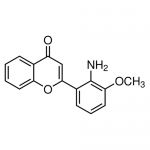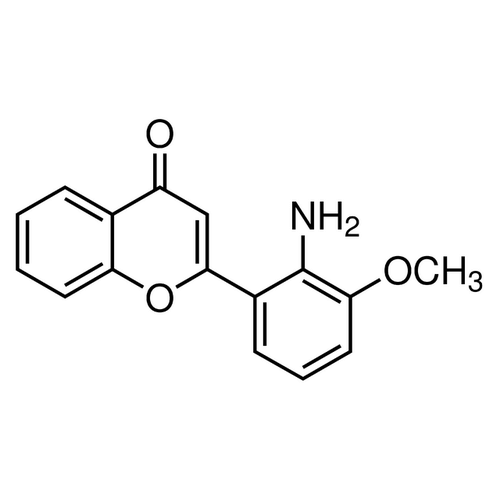| Product Name | PD98059 |
| Description |
MEK kinase inhibitor |
| Purity | >98% (HPLC); NMR (conforms) |
| CAS No. | 167869-21-8 |
| Molecular Formula | C16H13NO3 |
| Molecular Weight | 267.3 |
| Field of Use | Not for use in humans. Not for use in diagnostics or therapeutics. For in vitro research use only. |
Properties
| Storage Temperature | -20ºC |
| Shipping Temperature | Shipped Ambient |
| Product Type | Inhibitor |
| Solubility | May be dissolved in DMSO (6mg/mL) |
| Source | Synthetic |
| Appearance | Pale yellow solid |
| SMILES | COC1=CC=CC(=C1N)C2=CC(=O)C3=CC=CC=C3O2 |
| InChI | InChI=1S/C16H13NO3/c1-19-14-8-4-6-11(16(14)17)15-9-12(18)10-5-2-3-7-13(10)20-15/h2-9H,17H2,1H3 |
| InChIKey | QFWCYNPOPKQOKV-UHFFFAOYSA-N |
| Safety Phrases |
Classification: Acute toxicity, Oral (Category 3), H301 Safety Phrases: S22 - Do not breathe dust. S24/25 - Avoid contact with skin and eyes. S36/37/39 - Wear suitable protective clothing, gloves and eye/face protection. Hazard statements: H301 Toxic if swallowed. Precautionary statements: P264 Wash skin thoroughly after handling. P270 Do not eat, drink or smoke when using this product. P301 + P310 IF SWALLOWED: Immediately call a POISON CENTER or doctor/ physician. P321 Specific treatment (see supplemental first aid instructions on this label). P330 Rinse mouth. P405 Store locked up. P501 Dispose of contents/ container to an approved waste disposal plant. |
| Cite This Product | PD98059 (StressMarq Biosciences Inc., Victoria BC CANADA, Catalog # SIH-466) |
Biological Description
| Alternative Names | 2-(2-Amino-3-methoxyphenyl)-4H-1-benzopyran-4-one, PD98059 |
| Research Areas | Apoptosis, Cancer, Cancer Growth Inhibitors, Cell Signaling, Tyrosine Kinase Inhibitors |
| PubChem ID | 4713 |
| Scientific Background | PD98059 is a potent, selective, and reversible inhibitor of MEK1, a kinase upstream of ERK in the MAPK signaling cascade. It binds to the inactive form of MEK1, preventing its activation and subsequent phosphorylation of ERK. In neurodegenerative disease research, PD98059 is used to study the role of MAPK/ERK signaling in neuronal survival, synaptic plasticity, and memory. It is also employed to investigate the impact of ERK inhibition on neuroinflammation and oxidative stress, making it a valuable tool in models of Alzheimer’s and Parkinson’s disease. |
| References |
1. Alessi D.R., Cuenda A., Cohen P., Dudley D.T., & Saltiel A.R. (1995) J. Biol. Chem. 270(46): 27489–27494. 2. Qi X., et al. (2004) Pro. Nat. Acad. Sci. USA. 101(16): 6027–6032. 3. Dudley D.T., Pang L., Decker S.J., Bridges A.J., & Saltiel A.R. (1995) Pro. Nat. Acad. Sci. USA. 92(17): 7686–7689. |



Reviews
There are no reviews yet.